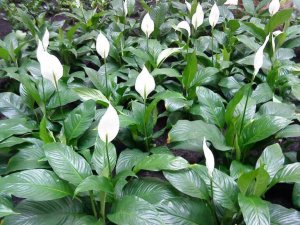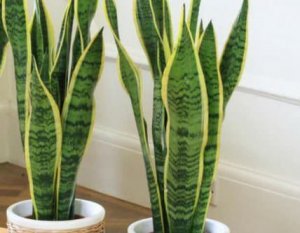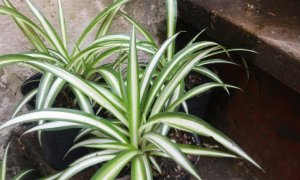Plants that Eliminate Toxins and Purify the Air

Cigarette smoke, car fumes, pollution, and even the use of certain electronic devices… All these things destroy the purity of the air in our homes. As such, people often recommend buying certain types of plants that are said to have the ability to purify the environment and eliminate toxins.
Which plants can purify the air?
Until recently, many people believed that keeping plants in your bedroom could be bad for your health, as they thought they used up some of our oxygen. While it is true that plants need oxygen to survive, some are also able to absorb carbon dioxide and toxins.
Yes, you read that right. For that reason, these plants are highly valued by many people. In this article, we’ll tell you which plants are able to eliminate benzene, tolueno, formaldehyde and ammonium from the environment.
1. Spathiphyllum

Also known as spath or peace lilies, the spathiphyllum is a tropical plant with large dark leaves. Its white flowers have a yellow or green spathe, and grow in a spadix shape.
Spathiphyllum don’t require much light or water to survive. They have a fairly long lifespan, and reproduce by division. When this happens, you’ll need to move the plant to a larger pot, and make sure the soil contains plenty of dried leaves, sand and natural charcoal.
2. Plants that can purify the air – pothos

Pothos is known by a number of different names, including Hunter’s robe, Ceylon creeper, Silver vine and Devil’s vine. One of the most famous and popular houseplants in the world, pothos is a type of vine, with thick stems which use aerial roots to climb. When grown outside, they can grow to heights of up to heights of over 65 ft.
Pothos are great ornamneed ental plants, with green or yellow leaves. They’re hardy, require very little care, and to be trained in order to encourage them to climb. They can’t be kept in extremely warm climates, or left in direct sunlight. The only downside is that they can be toxic to dogs and cats if ingested.
3. Snake plant

The snake plant’s scientific name is Sansevieria trifasciata. It’s native to tropical West Africa, and gets its name from the shape and sharp angles of its leaves. It’s also known as Mother-in-Law’s Tongue or Saint George’s sword.
This plant is mainly dark green in color, with yellow margins along the edges of the leaves, and clear markings along the center. It is an ornamental, indoor plant that’s resistant to harsh weather conditions. According to popular belief, the snake plant can purify the air by removing benzene and formaldehyde.
4. Plants that can purify the air – the jade tree

This plant originates from South Africa, and belongs to the succulent family. Its branches are thick and its leaves are fleshy, with rounded ages and a bright, jade green color (which is where it gets its name), although they can also be reddish in tone.
If you keep them in good condition, jade trees can produce pink and white flowers in the winter and fall. They require an average amount of water (though this can be decreased in cold weather), and partial shade. They can’t tolerate extreme temperatures or direct sunlight. You’ll also need to prune them from time to time, so that the trunk of the plant can support the weight of the branches and leaves.
5. Spider plant

These are really beautiful plants. Their fine leaves are dark green on the outside, with a white stripe down the middle. They’re resistant to cold, lack of light, and lack of water, as they can store water or humidity in their roots.
As for their purifying properties, many believe that spider plants can eliminate carbon monoxide and formaldehyde from the air, among other toxins. They’re also fairly hardy plants, and can live for a number of years.
6. Plants that can purify the air – bromelia

When we talk about bromelia, we aren’t referring to one single species, but a whole family of tropical plants with very deep calyxes. According to one study, they have the ability to absorb up to 80% of toxins such as benzene from the air in just 12 hours.
They’re excellent for both homes and offices. These herbaceous plants can grow on rock, and can develop into small trees.
7. Cornstalk or happy plant

Also known by its scientific name, Dracaena fragans, the cornstalk plant is a slow-growing tropical shrub. Its leaves are fleshy and dark green in color, while its flowers can be pink or white, and are so fragrant that they often attract hummingbirds.
When planted directly in the soil, they can grow up to 20 ft in height. In a plant pot, however, they won’t grow much more than 3 ft. They eliminate chemicals from the air, including toluene, xylene, and formaldehyde.
While many studies have refuted the idea that these plants can effectively remove toxins from the air, many people still believe them to be beneficial. Either way, they’ll make a great addition to your decor. So, have you decided which one you’re going to buy for your home?
Cigarette smoke, car fumes, pollution, and even the use of certain electronic devices… All these things destroy the purity of the air in our homes. As such, people often recommend buying certain types of plants that are said to have the ability to purify the environment and eliminate toxins.
Which plants can purify the air?
Until recently, many people believed that keeping plants in your bedroom could be bad for your health, as they thought they used up some of our oxygen. While it is true that plants need oxygen to survive, some are also able to absorb carbon dioxide and toxins.
Yes, you read that right. For that reason, these plants are highly valued by many people. In this article, we’ll tell you which plants are able to eliminate benzene, tolueno, formaldehyde and ammonium from the environment.
1. Spathiphyllum

Also known as spath or peace lilies, the spathiphyllum is a tropical plant with large dark leaves. Its white flowers have a yellow or green spathe, and grow in a spadix shape.
Spathiphyllum don’t require much light or water to survive. They have a fairly long lifespan, and reproduce by division. When this happens, you’ll need to move the plant to a larger pot, and make sure the soil contains plenty of dried leaves, sand and natural charcoal.
2. Plants that can purify the air – pothos

Pothos is known by a number of different names, including Hunter’s robe, Ceylon creeper, Silver vine and Devil’s vine. One of the most famous and popular houseplants in the world, pothos is a type of vine, with thick stems which use aerial roots to climb. When grown outside, they can grow to heights of up to heights of over 65 ft.
Pothos are great ornamneed ental plants, with green or yellow leaves. They’re hardy, require very little care, and to be trained in order to encourage them to climb. They can’t be kept in extremely warm climates, or left in direct sunlight. The only downside is that they can be toxic to dogs and cats if ingested.
3. Snake plant

The snake plant’s scientific name is Sansevieria trifasciata. It’s native to tropical West Africa, and gets its name from the shape and sharp angles of its leaves. It’s also known as Mother-in-Law’s Tongue or Saint George’s sword.
This plant is mainly dark green in color, with yellow margins along the edges of the leaves, and clear markings along the center. It is an ornamental, indoor plant that’s resistant to harsh weather conditions. According to popular belief, the snake plant can purify the air by removing benzene and formaldehyde.
4. Plants that can purify the air – the jade tree

This plant originates from South Africa, and belongs to the succulent family. Its branches are thick and its leaves are fleshy, with rounded ages and a bright, jade green color (which is where it gets its name), although they can also be reddish in tone.
If you keep them in good condition, jade trees can produce pink and white flowers in the winter and fall. They require an average amount of water (though this can be decreased in cold weather), and partial shade. They can’t tolerate extreme temperatures or direct sunlight. You’ll also need to prune them from time to time, so that the trunk of the plant can support the weight of the branches and leaves.
5. Spider plant

These are really beautiful plants. Their fine leaves are dark green on the outside, with a white stripe down the middle. They’re resistant to cold, lack of light, and lack of water, as they can store water or humidity in their roots.
As for their purifying properties, many believe that spider plants can eliminate carbon monoxide and formaldehyde from the air, among other toxins. They’re also fairly hardy plants, and can live for a number of years.
6. Plants that can purify the air – bromelia

When we talk about bromelia, we aren’t referring to one single species, but a whole family of tropical plants with very deep calyxes. According to one study, they have the ability to absorb up to 80% of toxins such as benzene from the air in just 12 hours.
They’re excellent for both homes and offices. These herbaceous plants can grow on rock, and can develop into small trees.
7. Cornstalk or happy plant

Also known by its scientific name, Dracaena fragans, the cornstalk plant is a slow-growing tropical shrub. Its leaves are fleshy and dark green in color, while its flowers can be pink or white, and are so fragrant that they often attract hummingbirds.
When planted directly in the soil, they can grow up to 20 ft in height. In a plant pot, however, they won’t grow much more than 3 ft. They eliminate chemicals from the air, including toluene, xylene, and formaldehyde.
While many studies have refuted the idea that these plants can effectively remove toxins from the air, many people still believe them to be beneficial. Either way, they’ll make a great addition to your decor. So, have you decided which one you’re going to buy for your home?
All cited sources were thoroughly reviewed by our team to ensure their quality, reliability, currency, and validity. The bibliography of this article was considered reliable and of academic or scientific accuracy.
Pedraza, Lady. (2015). La Biodepuración del Aire con Plantas Purificantes y Ornamentales, como Alternativa Ambiental en el Siglo XXI. Repositorio Institucional Universidad Distrital – RIUD.







